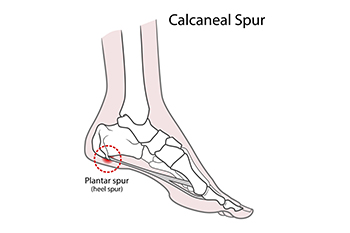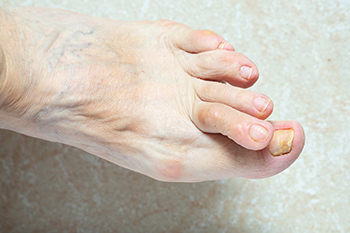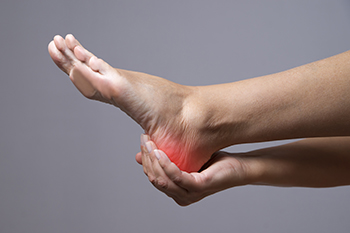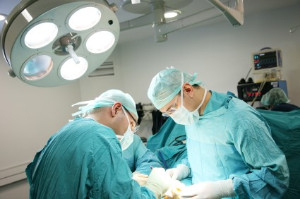Blog
Items filtered by date: November 2023
Relationship of Heel Spurs to Plantar Fasciitis

It is a common misconception that heel spurs are the primary cause of heel pain. In reality, heel spurs, which are bony projections on the heel bone, are often found by having an X-ray taken, and cause pain in only 5 percent of individuals with them. The majority of heel pain is generally due to plantar fasciitis, an inflammation of the plantar fascia tissue which stretches from the heel to the toes. While many individuals with plantar fasciitis also have heel spurs, the pain is typically from the damaged plantar fascia, not the spurs themselves. Heel spur syndrome and plantar fasciitis share similar risk factors, like athletic stress, obesity, calf tightness, high arches, and possibly osteoarthritis. Both conditions often respond to non-surgical treatments, including rest, footwear changes, and stretching. If these do not work, injections or plantar fasciotomy surgery might be recommended, though the heel spur is typically not removed during surgery. If you have heel pain, it is strongly suggested that you make an appointment with a podiatrist for a proper diagnosis and correct treatment methods.
Heel spurs can be incredibly painful and sometimes may make you unable to participate in physical activities. To get medical care for your heel spurs, contact Queen Mbanuzue, DPM from In Step Podiatry Center. Our doctor will do everything possible to treat your condition.
Heels Spurs
Heel spurs are formed by calcium deposits on the back of the foot where the heel is. This can also be caused by small fragments of bone breaking off one section of the foot, attaching onto the back of the foot. Heel spurs can also be bone growth on the back of the foot and may grow in the direction of the arch of the foot.
Older individuals usually suffer from heel spurs and pain sometimes intensifies with age. One of the main condition's spurs are related to is plantar fasciitis.
Pain
The pain associated with spurs is often because of weight placed on the feet. When someone is walking, their entire weight is concentrated on the feet. Bone spurs then have the tendency to affect other bones and tissues around the foot. As the pain continues, the feet will become tender and sensitive over time.
Treatments
There are many ways to treat heel spurs. If one is suffering from heel spurs in conjunction with pain, there are several methods for healing. Medication, surgery, and herbal care are some options.
If you have any questions feel free to contact our office located in Lanham, MD . We offer the latest in diagnostic and treatment technology to meet your needs.
Hammertoe Is a Common Foot Deformity

Hammertoe is a prevalent and often uncomfortable foot deformity that affects the toes, typically the second, third, or fourth toes. The condition gets its name from the toe's appearance, as the affected toe tends to bend or contract at the middle joint, resembling a hammer. Hammertoes can result from various causes, including wearing poorly fitting footwear that squeezes the toes and forces them into an unnatural position. High heels, in particular, are known culprits. Hammertoe can also be caused by an imbalance in the muscles, tendons, or ligaments that control the toe's movement, leading to an abnormal bend. Some individuals may have a genetic predisposition to the condition. Arthritis, injury, or nerve damage can also contribute to the development of hammertoes. The deformity can lead to discomfort, corns, calluses, or open sores due to friction with shoes. Early intervention is essential, and conservative treatments may be successful. In severe cases, surgery may be necessary to straighten the affected toe. If you have developed hammertoe, it is suggested that you visit a podiatrist who can determine its severity, followed by choosing the best course of treatment for you.
Hammertoes can be a painful condition to live with. For more information, contact Queen Mbanuzue, DPM of In Step Podiatry Center. Our doctor will answer any of your foot- and ankle-related questions.
Hammertoe
Hammertoe is a foot deformity that occurs due to an imbalance in the muscles, tendons, or ligaments that normally hold the toe straight. It can be caused by the type of shoes you wear, your foot structure, trauma, and certain disease processes.
Symptoms
- Painful and/or difficult toe movement
- Swelling
- Joint stiffness
- Calluses/Corns
- Physical deformity
Risk Factors
- Age – The risk of hammertoe increases with age
- Sex – Women are more likely to have hammertoe compared to men
- Toe Length – You are more likely to develop hammertoe if your second toe is longer than your big toe
- Certain Diseases – Arthritis and diabetes may make you more likely to develop hammertoe
Treatment
If you have hammertoe, you should change into a more comfortable shoe that provides enough room for your toes. Exercises such as picking up marbles may strengthen and stretch your toe muscles. Nevertheless, it is important to seek assistance from a podiatrist in order to determine the severity of your hammertoe and see which treatment option will work best for you.
If you have any questions, please feel free to contact our office located in Lanham, MD . We offer the newest diagnostic and treatment technologies for all your foot care needs.
Symptoms and Diagnosis of Heel Pain

Heel pain can come from many different things. The area of the heel that is painful can give clues about the cause. The most frequent cause of heel pain is plantar fasciitis, which is characterized by sharp pain on the bottom of the heel when standing after sitting or lying down. Heel pain can also come from a crack in the heel bone, if one has been more active or walked on hard ground. Pain at the back of the heel can arise from problems with the Achilles tendon, or, if the tendon at another spot is hurting, that is where the pain will be. A bony bump on the heel that causes swelling or pain can also cause back of heel pain. If the inside part of the foot hurts after standing for a long time, it may indicate a nerve is being compressed. Additionally, if the outside part of the foot hurts or feels wobbly, especially when active or on rough ground, it could be sinus tarsi syndrome. If you have any kind of heel pain, it is suggested that you make an appointment with a podiatrist for a proper diagnosis and treatment plan.
Many people suffer from bouts of heel pain. For more information, contact Queen Mbanuzue, DPM of In Step Podiatry Center. Our doctor can provide the care you need to keep you pain-free and on your feet.
Causes of Heel Pain
Heel pain is often associated with plantar fasciitis. The plantar fascia is a band of tissues that extends along the bottom of the foot. A rip or tear in this ligament can cause inflammation of the tissue.
Achilles tendonitis is another cause of heel pain. Inflammation of the Achilles tendon will cause pain from fractures and muscle tearing. Lack of flexibility is also another symptom.
Heel spurs are another cause of pain. When the tissues of the plantar fascia undergo a great deal of stress, it can lead to ligament separation from the heel bone, causing heel spurs.
Why Might Heel Pain Occur?
- Wearing ill-fitting shoes
- Wearing non-supportive shoes
- Weight change
- Excessive running
Treatments
Heel pain should be treated as soon as possible for immediate results. Keeping your feet in a stress-free environment will help. If you suffer from Achilles tendonitis or plantar fasciitis, applying ice will reduce the swelling. Stretching before an exercise like running will help the muscles. Using all these tips will help make heel pain a condition of the past.
If you have any questions please contact our office located in Lanham, MD . We offer the newest diagnostic and treatment technologies for all your foot and ankle needs.
It's Time for Beautiful Feet
Types of Ankle Ligament Surgery

The ankle is a complex joint consisting of the subtalar joint, tibiotalar joint, and distal tibiofibular joint. It relies on ligaments to prevent excessive movement and ensure stability. When these ligaments become compromised, ankle surgery may be an option. In such cases, anatomical reconstruction is the preferred approach for repairing damaged ankle ligaments. This procedure aims to restore torn or stretched ligaments and can use either the patient's own tissue or a cadaver tendon, depending on the ligament's condition. During anatomical reconstruction, an ankle surgeon may also tighten the fibrous tissue band to improve ankle alignment and prevent future injuries. In contrast, peroneal substitution ligament reconstruction involves replacing the damaged ligament with another tendon harvested from the patient's ankle. While a viable option, it is generally considered less effective than anatomical reconstruction. Recovery times for both procedures are roughly six weeks, but it may be much longer before you can safely resume sports activities. The choice of surgery should be made in consultation with a podiatrist who is a qualified foot and ankle surgeon. This foot doctor will tailor the surgery to your specific needs and follow with thorough post-operative care and rehabilitation. If you have severely injured your ankle, it is suggested that you make an appointment with a podiatrist as quickly as possible.
Foot surgery is sometimes necessary to treat a foot ailment. To learn more, contact Queen Mbanuzue, DPM of In Step Podiatry Center. Our doctor will assist you with all of your foot and ankle needs.
When Is Surgery Necessary?
Foot and ankle surgery is generally reserved for cases in which less invasive, conservative procedures have failed to alleviate the problem. Some of the cases in which surgery may be necessary include:
- Removing foot deformities like bunions and bone spurs
- Severe arthritis that has caused bone issues
- Cosmetic reconstruction
What Types of Surgery Are There?
The type of surgery you receive will depend on the nature of the problem you have. Some of the possible surgeries include:
- Bunionectomy for painful bunions
- Surgical fusion for realignment of bones
- Neuropathy decompression surgery to treat nerve damage
Benefits of Surgery
Although surgery is usually a last resort, it can provide more complete pain relief compared to non-surgical methods and may allow you to finally resume full activity.
Surgical techniques have also become increasingly sophisticated. Techniques like endoscopic surgery allow for smaller incisions and faster recovery times.
If you have any questions please feel free to contact our office located in Lanham, MD . We offer the newest diagnostic and treatment technologies for all your foot and ankle needs.
Blog Archives
- January 2025
- December 2024
- November 2024
- October 2024
- September 2024
- August 2024
- July 2024
- June 2024
- May 2024
- April 2024
- March 2024
- February 2024
- January 2024
- December 2023
- November 2023
- October 2023
- September 2023
- August 2023
- July 2023
- June 2023
- May 2023
- April 2023
- March 2023
- February 2023
- January 2023
- December 2022
- November 2022
- October 2022
- September 2022
- August 2022
- July 2022
- June 2022
- May 2022
- April 2022
- March 2022


